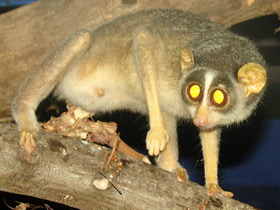The gray slender loris (Loris lydekkerianus)
 The grey slender lorises (Loris lydekkerianus) are listed as endangered on the IUCN Red List
The grey slender lorises (Loris lydekkerianus) are listed as endangered on the IUCN Red List
The gray slender loris (Loris lydekkerianus) is a species of primate in the family Loridae. It is native to India and Sri Lanka and inhabits subtropical and tropical dry forests and subtropical or tropical moist lowland forests. It is threatened by habitat loss.
Taxonomy
Together with the red slender loris (Loris tardigradus), the grey slender loris (Loris lydekkerianus) is a type of slender loris (genus Loris) in the strepsirrhine primate family Lorisidae. In 1908 Spanish zoologist Ángel Cabrera first described the Mysore slender loris (Loris tardigradus lydekkerianus) in Chennai, India, which he named for the English naturalist Richard Lydekker. This subspecies was further described by William Charles Osman Hill in his seminal primate book Primates: Comparative Anatomy and Taxonomy (1953). Hill believed there was one species of slender loris which was further split into six subspecies, two in India and four in Sri Lanka. In 1998 biological anthropologist Colin Groves recognised two species, Loris tardigradus and Loris lydekkerianus, which have been widely accepted by the scientific community. Loris lydekkerianus now includes four geographically separated subspecies, Loris lydekkerianus lydekkerianus (previously Loris tardigradus lydekkerianus) and Loris lydekkerianus malabaricus in India and Loris lydekkerianus nordicus and Loris lydekkerianus grandis in Sri Lanka.
Genus Loris
- Red slender loris, Loris tardigradus;
- Gray slender loris, Loris lydekkerianus;
- Malabar slender loris, Loris lydekkerianus malabaricus;
- Mysore slender loris, Loris lydekkerianus lydekkerianus;
- Northern Ceylonese slender loris, Loris lydekkerianus nordicus;
- Highland slender loris, Loris lydekkerianus grandis.
A slender loris group known as the montane slender loris (taxon nycticeboides) has had uncertain classification and variously placed as a subspecies of Loris lydekkerianus, Loris tardigradus, and as a distinct species. A 2019 study based on partial CO1 sequences showed the taxon can be classified in a single haplogroup with Loris tardigradus tardigradus.
Habitat
Loris lydekkerianus is a species of strepsirrhine primate belonging to the family Lorisidae.
Loris lydekkerianus is found in southern India and Sri Lanka in humid lowland tropical rainforests and dry subtropical forests. The species is named after the English zoologist Richard Lydekker (1849-1915). Within the species several geographically distinct subspecies are distinguished, in particular the subspecies Loris lydekkerianus nordicus, which is distributed in northern and central Sri Lanka and is listed as endangered in the IUCN Red List. However, a long-term study of this subspecies has found that lorises can tolerate human presence to some extent and populate secondary forests if there is dense undergrowth.
Nutrition and social behaviour
Like other lories, Loris lydekkerianus is a nocturnal animal, leaving its shelter only at dusk. It feeds mainly on insects, but may also eat small lizards, mainly geckos, tree frogs, small birds and their eggs. In southeastern India, these animals are most commonly found in acacia and tamarack thickets and bush thickets around fields. Loris lydekkerianus feeds alone, but may form groups of up to 7 individuals during the day. These groups usually include a female and her young. They mark territorial boundaries with urine. They also communicate by a system of visual and sound signals. Social behaviour is limited to roosting sites.
Reproduction
Loris lydekkerianus does not form permanent pairs. Throughout the year, the female may mate with different males and the male with different females. During the mating season, the female is often chased by several males, and this chase can last for many hours. Although the mating season occurs twice a year (April to June and October to December), the young are born only once a year.
Pregnancies last about 170 days. There are usually one or two pups per litter and the interval between births is about 7 months (so a female can have a maximum of 4 pups per year).
During the first three days, the mother licks them constantly, then only when they make special noises. For about 4 weeks the female carries the calf on her body all the time, then she starts to leave it near her sleeping place, goes to feed and returns only at dawn.
Interestingly, the abandoned cubs are often visited by males and immature specimens, who clean them or play with them. It is not known what their relationship with the calf is, but it is noted that the calf is always part of the group in which it sleeps during the day. The mother stops nursing the cub at around 5 months of age, but feeds it with a special, highly nutritious milk for some time before doing so.
Conservation status
Although considered near threatened on the IUCN Red List and classified under Schedule I (Part 1) of the Indian Wildlife Act, 1972, the threat to these primates is increasing. Loris is used to make love potions, treat leprosy and eye ailments. Some villagers keep lorises as pets, but because they are difficult to maintain there is high mortality. Some cities have them captive in zoos, and astrologers use them to pick out tarot cards. Insects form the main source of food for lorises. Farmlands, which are high in cattle waste, produce large amounts of insects. Thus lorises do not compete with humans for resources and therefore tend to be tolerated by them. Habitat fragmentation is also a threat to the loris population, as well as loss of acacia trees, which is a preferred tree species for the loris. Conservation efforts are developing and more research on conservation efforts are ongoing.
















































